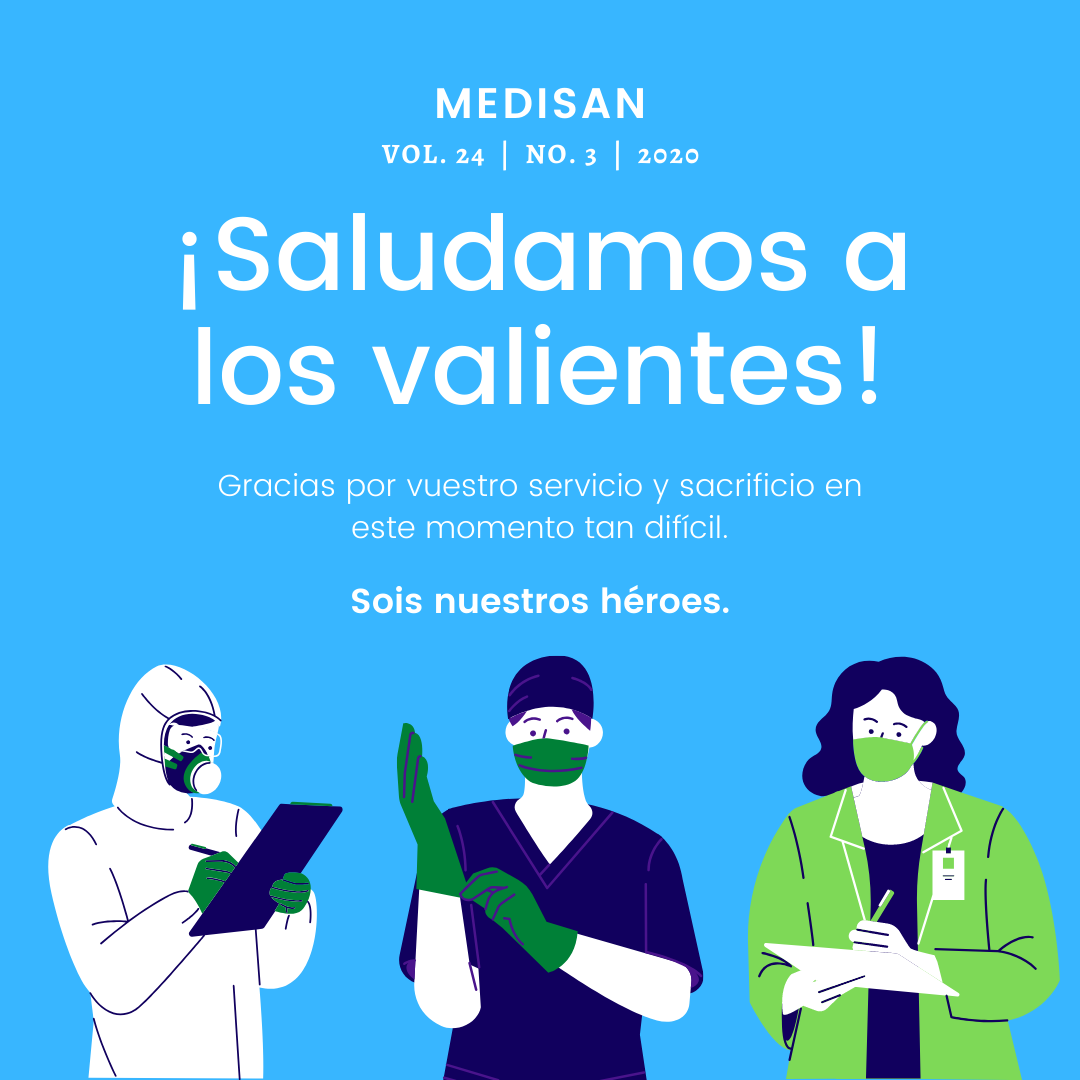Clinical and epidemiological characterization of patients confirmed with COVID-19 in Santiago de Cuba
Keywords:
child, adult, coronavirus, pandemic, COVID-19, asymptomatic cases, secondary health care.Abstract
Introduction: The exponential increment of confirmed cases with the new coronavirus SARS-CoV-2 forced the authorities of the Health World Organization to declare as pandemic this health emergency.
Objective: to characterize children and adults confirmed with the COVID-19 from the clinical and epidemiological points of view.
Methods: An observational, descriptive and cross-sectional study of 74 patients confirmed with the COVID-19 who were admitted to Dr. Joaquín Castillo Duany Teaching Clinical Surgical Hospital was carried out in Santiago de Cuba, from March to May, 2020. The data were obtained from the medical records of the affected patients. Among the analyzed variables we have: age, sex, lethality, discharge state, place of origin of the cases and beginning of COVID-19 symptoms before admission to hospital.
Results: A prevalence of the male sex (52.7 %) was found. There was a tendency to the hospital admission of confirmed asymptomatic patients, of them 50.0 % of the 1 to 17 age group; 94.5 % of the affected patients were alive when discharged of the institution. No kids were notified in serious or critical condition. Cough (60.0 %), fever (34.5 %) and breathlessness (21.8 %) were the most referred clinical features.
Conclusions: With a biosocial approach a first experience is informed in the care to confirmed patients with COVID-19 in Santiago de Cuba. The clinical and epidemiological diagnosis favored to register the highest incidence in this disease in symptomatic young adults and to identify other patients that transmitted the virus without manifesting symptoms.Downloads
References
2. Pareja Cruz A, Luque Espino JC. Alternativas terapéuticas farmacológicas para COVID-19. Rev Horizonte Médico. 2020 [citado 30/04/2020]; 20(2). Disponible en: http://www.horizontemedico.usmp.edu.pe/index.php/horizontemed/article/view/1216/710
3. Giralt Herrera A, Rojas Velázquez JM, Leiva Enríquez J. Relación entre COVID-19 e hipertensión arterial. Revista Habanera de Ciencias Médicas. 2020 [citado 27/05/2020]; 19 (2). Disponible en: http://www.revhabanera.sld.cu/index.php/rhab/article/view/3246/2547
4. Sagardia J, Orlandi C, Romero V, San Emeterio J, Lozano J, Bongioanni H, et al. Recomendaciones para el tratamiento del paro cardiorrespiratorio en pacientes adultos con COVID-19. Rev Arg de Ter Int. 2020 [citado 4/05/2020]; S (1). Disponible en: https://revista.sati.org.ar/index.php/MI/article/view/691/798
5. Ruíz Bravo A, Jiménez Varela M. SARS-CoV-2 y pandemia de síndrome respiratorio agudo (COVID-19). Rev Universidad de Granada. 2020 [citado 30/04/2020]; 61 (2). Disponible en: https://revistaseug.ugr.es/index.php/ars/article/view/15177
6. Pérez Abreu MR, Gómez Tejeda JJ, Dieguez Guach RA. Características clínico-epidemiológicas de la COVID-19. Rev haban cienc méd. 2020 [citado 30/04/ 2020]; 19 (2). Disponible en http://www.revhabanera.sld.cu/index.php/rhab/article/view/3254/2562
7. Espinosa Brito A. Reflexiones a propósito de la pandemia de COVID-19: del 18 de marzo al 2 de abril de 2020. Anales de la Academia de Ciencias de Cuba. 2020 [citado 30/04/2020]; 10 (2). Disponible en: http://revistaccuba.sld.cu/index.php/revacc/article/view/765/797
8. Almaguer Mederos LE, Cuello Almarales D, Almaguer Gotay D. Rol de los genes ACE2 y TMPRSS2 en la susceptibilidad o gravedad de la COVID-19. Anales de la Academia de Ciencias de Cuba. 2020 [citado 25/05/2020]; 10 (2). Disponible en: http://www.revistaccuba.sld.cu/index.php/revacc/article/view/799/860
9. Ruiz Cantero MT. Las estadísticas sanitarias y la invisibilidad por sexo y de género durante la epidemia de COVID-19. Gaceta Sanitaria. 2020 [citado 12/05/2020]. Disponible en: https://www.gacetasanitaria.org/es-las-estadisticas-sanitarias-invisibilidad-por-avance-S0213911120300911
10. Chen N, Zhou M, Dong X, Qu J, Gong R, Han Y, et al. Epidemiological and clinical characteristics of 99 cases of 2019 novel coronavirus pneumonia in Wuhan, China: a descriptive study. Lancet. 2020 [citado 12/05/2020]; 39 (10223). Disponible en: https://www.thelancet.com/pdfs/journals/lancet/PIIS0140-6736(20)30211-7.pdf
11. Red Nacional de Vigilancia Epidemiológica. Informe sobre la situación de COVID-19 en España. Madrid: Centro Nacional de Epidemiología; 2020. Report No.: 14. [citado 12/05/2020] Disponible en: https://www.isciii.es/QueHacemos/Servicios/VigilanciaSaludPublicaRENAVE/EnfermedadesTransmisibles/Documents/INFORMES/Informes%20COVID-19/Informe%20n%C2%BA%2014.%20Situaci%C3%B3n%20de%20COVID-19%20en%20Espa%C3%B1a%20a%2024%20marzo%20de%202020.pdf
12. Smith J. Overcoming the ‘tyranny of the urgent’: integrating gender into disease outbreak preparedness and response. Gender &Development. 2019 [citado 12/05/2020]; 27 (2). Disponible en: https://www.tandfonline.com/doi/full/10.1080/13552074.2019.1615288
13. Mizumoto K, Kagaya K, Zarebski A, Chowell G. Estimating the asymptomatic proportion of coronavirus disease 2019 (COVID-19) cases on board the Diamond Princess cruise ship, Yokohama, Japan, 2020. Euro Surveill. 2020 [citado 05/05/2020]; 25 (10). Disponible en: https://www.ncbi.nlm.nih.gov/pmc/articles/PMC7078829/
14. National Institute of Infectious Diseases. Field Briefing: Diamond Princess COVID-19 Cases, 20 Feb Update. 2020 [citado 04/03/2020]. Disponible en: https://www.niid.go.jp/niid/en/2019-ncov-e/9407-covid-dp-fe-02.htm
15. Bai Y, Yao L, Wei T. Presumed asymptomatic carrier transmission of COVID-19. JAMA. 2020 [citado 05/05/2020]; 323 (14). Disponible en: https://jamanetwork.com/journals/jama/fullarticle/2762028
16. Pan L, Mu M, Yang P, Sun Y, Wang R, Yan J, et al. Clinical characteristics of COVID-19 patient with digestive symptoms in hubei, China: A descriptive, cross sectional, multicenter study. Am J Gastroenterol. 2020 [citado 05/05/2020]; 115 (5). Disponible en: https://europepmc.org/article/pmc/pmc7172492
17. Aragón Nogales R, Vargas Almanza L, Miranda Novales MG. COVID-19 por SARS-CoV-2: la nueva emergencia de salud. Rev Mex Pediatr. 2019 [citado 05/05/2020]; 86 (6). Disponible en: https://www.medigraphic.com/pdfs/pediat/sp-2019/sp196a.pdf
18. World health Organization. Report of the WHO-China Joint Mission on Coronavirus Disease 2019 (COVID-19). 2020 [citado 05/05/2020]. Disponible en: https://www.who.int/docs/default-source/coronaviruse/who-china-joint-mission-on-covid-19-final-report.pdf
19. Soto Agüero MJ, Ureña Chavarría E. Infección por COVID-19 en niños, ¿Cómo afecta a la población pediátrica? Rev Méd Costa Rica. 2020; 85 (629): 29-36.
20. Palacios Cruz M, Santos E, Velázquez Cervantes MA, León Juárez M. COVID-19, una emergencia de salud pública mundial. Rev Clin Esp. 2020 [citado 11/05/2020]. Disponible en: https://www.ncbi.nlm.nih.gov/pmc/articles/PMC7102523/
Published
How to Cite
Issue
Section
License
All the articles can be downloaded or read for free. The journal does not charge any amount of money to the authors for the reception, edition or the publication of the articles, making the whole process completely free. Medisan has no embargo period and it is published under the license of Creative Commons, International Non Commercial Recognition 4.0, which authorizes the copy, reproduction and the total or partial distribution of the articles in any format or platform, with the conditions of citing the source of information and not to be used for profitable purposes.





